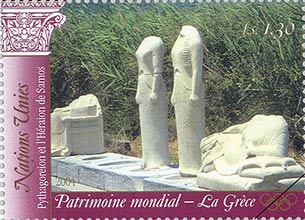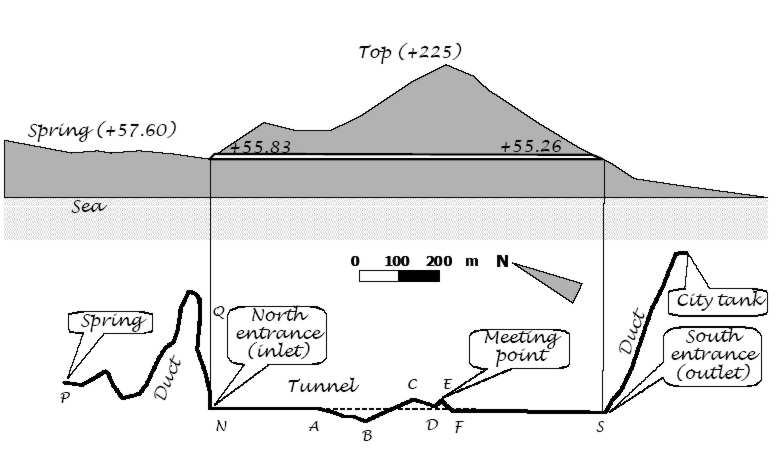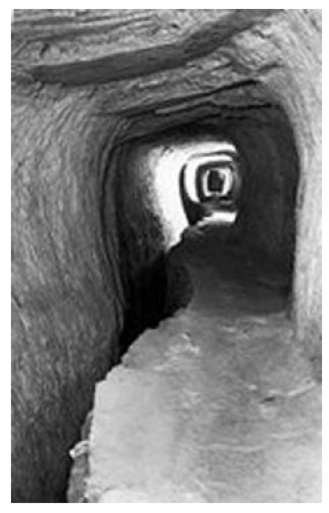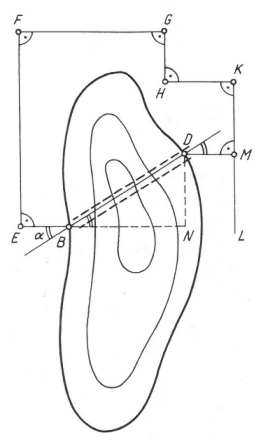.
Der Tunnel von Eupalinos
I have talked so much about the Samians, because, of all the Greeks, they have made the three greatest works of construction. One is a double-mouthed channel driven underground through a hill nine hundred feet high…The second is a mole in the sea around the harbor, one hundred a twenty feet deep. The length of the mole is a quarter of a mile. The third work of the Samians is the greatest temple that I have ever seen. Herodotus, Book 3
An obtused-prowed bireme version was produced in Samos during the period of Polycrates. The name of the first ship of this type was Samaina that could be used as a trading or as a warship (Athenaeus, Deipnosophistae). Samos was the birthplace of Pythagoras and Aristarchus. The capital town of Samos had a inadequate water supply making life difficult in the hot, dry summers. Herodotus says that Samos had a population of 300000 which seems too large to be true. The city could not resist for a long time enemy attacks. The mountains behind the town offered a source of water from the storms that broke over the mountain tops and the streams that ran through them.
For these reason the most famous hydraulic work of ancient Greece was build: The aqueduct of ancient Samos, which was admired both in antiquity (e.g. Herodotus) and in modern times. Herodotus considered the temple of Hera in Samos (Heraion), the Samian harbor and the Eupalinos tunnel one of the greatest things he had seen throughout his travels in the Ancient World. The harbor of Samos was build 540-523 BC during Polycrates. A wave breaker, 370 meters in length and 35 meters of depth inside the sea, was built for its protection. It is still there although due to the sinking of the ground now it is immersed at the bottom of the bay of Tigani.

World Heritage sites : The Heraion of Samos, sculptures at the Sacred way leading to the monumental Hera Temple.
A Tunnel, through Mount Kastro on Samos, was build to bring water from north of the mountain inside the fortifications of the city of Samos (modern Pythagoreon) to the south.
The most amazing part of the aqueduct is the 1036 m long, roughly 8 feet square, dug from two openings, «Ευπαλίνειον όρυγµα», or “Eupaninean digging”, after Eupalinos (Ευπαλίνος ο Μεγαρεύς) an engineer from Megara the son of Naustrophos. The construction started in 530 BC, during the tyranny of Polycrates and lasted for ten years. Polycrates used money that he obtained by various methods such as replacing silver coins with coins of lower quality, by piracy etc. The two working groups met in the center of the channel and they had only 60 cm error! The workers had problems because of unstable soil they found and had to make a deviation, but they managed to find again the right way to the opposite working team. The deviation was 200 metres away from a straight line connecting the ends of the tunnel in the heart of the mountain! Around 7000 cubic meter rock were removed from the mountain. Owing to the text of Herodotus, Guerin (1856) uncovered the entrance of the aqueduct. Only ninety years later, between 1971 and 1973, the German Archaeological Institute of Athens uncovered the entire tunnel (Hermann Kienast, 1977; Tsimpourakis, 1997).

Image from Demetris Koutsoyiannis Lectures

Image from Demetris Koutsoyiannis Lectures
The water was transported through a pipe constructed from 4000 smaller pieces produced manually. The tunnel was in operation for around 1000 years until 700 AD. Polycrates finally was killed by the Persians in 522 BC. Finally we should not forget that the work was done mostly by slaves, for example slaves from Lesbos.
References
T. E. Rihll and J. V. Tucker, Greek engineering: the case of Eupalinos' tunnel, in A Powell (ed) The Greek World, Routledge 1995.
Approximately 500 years later Heron described methods how to produce tunnels with his Dioptra. So the ancient Greeks must have a sufficient advanced geometric knowledge and the corresponding measuring devices to produce the Eupalinos channel.

Example by Heron how to use the Dioptra to construct a tunnel through two opposite points in a mountain. Take a point close to the first entrance B and another point E. Then use the Dioptra to obtain the perpendicular line EF and through a set of other perpendicular segments get line segment KL the point M for which DM is perpendicular to KL, where D is the other opposite entrance point. Using DN and NB estimate the angle alpha necessary to connect points B and D.
References
The Tunnel of Eupalinos, Engineering and Science, Tom Apostol, 2004, 1MB PDF File
Demetris Koutsoyiannis, Water resources technologies in the ancient Greece, School of Civil Engineering National Technical University of Athens
Buffet, B., and R. Evrard. (1950). L’Eau Potable a Travers Les Ages. Editions Soledi, Rue de la Province, 37, Liege, Belgium.
Dooge, J. C. I., (1988). Hydrology, past and present. Journal of Hydraulic Research, 26(1), 5-26.
Guerin, V. (1865). Description de l’Ile Patmos et de l’Ile Samos, Paris.
Kienast, H. J., Der Tunnel des Eupalinos auf Samos, Architectura, Zeitschrift für Geschichte der Architektur, 97-116, 1977.
Korres M. (2000), Water supply of Athens in antiquity (in Greek). Workshop: "Water and Environment", EYDAP, Athens.
Koutsoyiannis, D., and T. Xanthopoulos (1999). Engineering Hydrology (in Greek). 3rd edition, 418 pages, National Technical University of Athens, Athens.
Lazos, C. D. (1993). Mechanics and Technology in Ancient Greece (in Greek). Aeolos, Athens.
MacDowell, D. M. (1978). The Law in the Classical Athens. Thames and Hudson, London.
Papademos, D.L. (1975). The Hydraulic Works in Ancient Greece, Vol. B (in Greek). Ed. TEE, Athens.
Pappas, A. (1999). The Water Supply of Ancient Athens (in Greek). Eleuphtheri Skepsis, Athens.
Tsimpourakis, D. (1997). 530 BC, The Digging of Eupalinos in Ancient Samos (in Greek). Editions Arithmos, Athens.
U.S. Committee on Opportunities in the Hydrological Sciences (1991) Opportunities in the Hydrologic Sciences. National Academy Press, Washington, DC.
Paul Valery .. A dialogue with Socrates, Eupalinos and others..
German
Hermann J Kienast, Die Wasserleitung des Eupalinos auf Samos
Paul Valery, Rainer Maria Rilke, Eupalinos oder Der Architekt. Eingeleitet durch: Die Seele und der Tanz. (Eigentlich nicht über den Tunnel, aber doch eine dialog mit Sokrates und Eupalinos von Paul Valery)
Links
Quotations
Will anybody compare the idle Pyramids, or those other useless though much renowned works of the Greeks with these aqueducts, with these many indispensable structures? Sextus Julius Frontinus, The Water Supply of the City of Rome
| Ancient Greece
Science, Technology , Medicine , Warfare, , Biographies , Life , Cities/Places/Maps , Arts , Literature , Philosophy ,Olympics, Mythology , History , Images Medieval Greece / Byzantine Empire Science, Technology, Arts, , Warfare , Literature, Biographies, Icons, History Modern Greece Cities, Islands, Regions, Fauna/Flora ,Biographies , History , Warfare, Science/Technology, Literature, Music , Arts , Film/Actors , Sport , Fashion --- |

